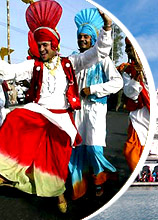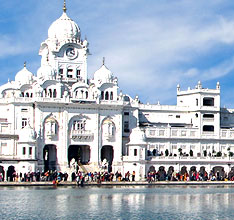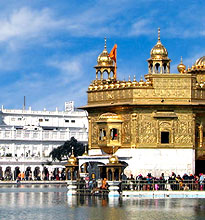 Jallianwala Bagh is historical for the murky day of 13 April 1919, when the innocent Indians were brutally killed in a mass. The Jallianwala Bagh Martyr's Memorial is built in memory of the innocent lives sacrificed in the deadly massacre with no good cause. It is situated in close affinity of the Golden Temple. It used to be a garden with an uneven and unoccupied space and an indifferently walled dumping ground. After the tragic happening in 1919, the place is revered as the pilgrimage centre, which thousands of tourists visit every year to pay homage to the martyrs.
Jallianwala Bagh is historical for the murky day of 13 April 1919, when the innocent Indians were brutally killed in a mass. The Jallianwala Bagh Martyr's Memorial is built in memory of the innocent lives sacrificed in the deadly massacre with no good cause. It is situated in close affinity of the Golden Temple. It used to be a garden with an uneven and unoccupied space and an indifferently walled dumping ground. After the tragic happening in 1919, the place is revered as the pilgrimage centre, which thousands of tourists visit every year to pay homage to the martyrs.History
Indians were highly agitated against the injustices of the British rule. There were several protests and revolts against the British rule throughout Punjab. The British Government had decided to place most of the Punjab under the marital law. A number of restrictions were imposed on civil liberties, like curtailing freedom of assembly, by banning of gatherings of more than four people. A large group of people had assembled in the Jallianwala Bagh on April 13, 1919 to celebrate the Baisakhi Fair. Under the new law of public gatherings being banned, the then Brigadier, Reginald Dyer, ordered open firing at the mass. He marched a group of 90 British Indian Army soldiers, mostly Gurkha, Punjab rifles, Pathans infantry, Dogra regiment and Baluchi regiment, into the park.
Jallianwala Bagh had only one main entrance, wherein the troops were stationed. Other entrances were locked and the entire bagh was bounded by houses and buildings. Without any prior warning to disperse, General Dyer ordered his soldiers to fire and continued the firing for around 1400 rounds, until the ammunition was exhausted. Hundreds of people were shot dead and many were killed by the stampede. Many people jumped into the well inside the Bagh to save themselves from the bullet, but were eventually drowned. Official records put the figures at 379 killed and 200 injured, though the original number went much beyond it.
Soon after the massacre, a committee was formed with Pandit Madan Mohan Malaviya as the President. The committee suggested raising a memorial at the bagh, to preserve the memory of the martyrs. Thus, the Jallianwala Bagh Martyr's Memorial came into being from 1st August, 1920. It was inaugurated by Dr. Rajendra Prasad on 13th April, 1961. Today, the ground has been converted into a memorial park, with beautiful lawns. At the entrance, a martyr's memorial has been erected in memory of the people who lost their life in the massacre. The memorial was built in 1960 with Rajasthan red stones having four stone lamps at its edge that looks like a flame and the foundation is made up of granite pieces.
The well inside the Bagh and the remnants of walls with bullet are preserved today as a monument. There is a gallery inside the garden dedicated to the martyrs containing photographs and letters of that period. On all four sides of the pylon, the words "in memory of martyrs, 13 April 1919” has been inscribed in Urdu, English and Punjabi. During summer it is open to tourists from 9 am to 5 pm and in winters from 10 am to 4 pm.












